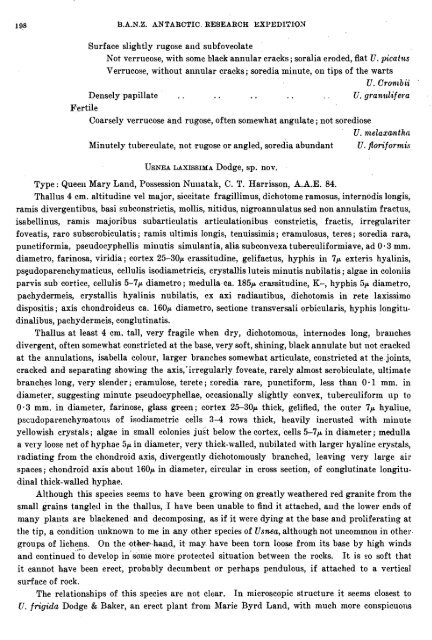Create successful ePaper yourself
Turn your PDF publications into a flip-book with our unique Google optimized e-Paper software.
B.A.N.Z. ANTARCTIC. RESEARCH EXI'EDITION<br />
Surface slightly rugose and subfoveolate<br />
Not verrncose, with somc black annular cracks; soralia eroded, flat U. yicat?~<br />
Verrucose, without annular cracks; soredia minute, on tips of the warts<br />
U. Crontbii<br />
Densely papillate . . . . . . . . . . Ti. granzilifera<br />
Fertile<br />
Coarsely verrucose and rugose, often somewhat angulate ; not sorediose<br />
U. ntelaxanthci<br />
Minutely tuberculate, not Tugose or angled, soredia abundant U. floriforntis<br />
USNEA LAXISSIMA Dodge, sp. nov.<br />
Type : Queeii Mary Land, Possession Nuiiatak, C. T. Harrisson, A.A.E. 84.<br />
Thallus 4 cm. altitudine vel major, siccitate fragillimus, dichotome ramosus, internodis longis,<br />
ramis divergentibus, basi subconstrictis, mollis, nitidus, nigroannulatus sed non annulatim fractus,<br />
isabellinus, ramis majoribus subarticulatis articulationibus constrictis, fractis, irregulariter<br />
foveatis, raro subscrobiculatis; ramis ultimis longis, tenuissimis; eramulosus, teres; soredia rars,<br />
punctiformia, pseudocyphellis minutis simulantia, alia subconvexa tuberculiformiave, ad 0.3 mm.<br />
diametro, farinosa, viridia ; cortex 25-30p crassitudine, gelifactus, hyphis in 7,~ exteris hyalinis,<br />
psgudoparenchymaticus, cellulis isodiametricis, crystallis luteis minutis nubilatis ; algae in coloniis<br />
parvis sub cortice, cellulis 5-7p diametro; medulla ca. 185p crassitudine, K-, hyphis 5 ,~ diametro,<br />
pachydermeis, crystallis hyalinis nubilatis, ex axi radiantibus, dichotomis in rete laxissimo<br />
dispositis ; axis chondroideus ca. 16OP diametro, sectione transversali orbicularis, hyphis longitudinalibus,<br />
pachydermeis, conglutinatis.<br />
Thallus at least 4 cm. tall, very fragile when dry, dichotomous, internodes long, branches<br />
divergent, often somewhat conetricted at the base, very soft, shining, black annulate but uot craclrecl<br />
at the annulations, isabella colour, larger branches somewhat articulate, constricted at the joints,<br />
cracked and separating showing the axis,'irregularly foveate, rarely almost scrobiculate, ultimate<br />
branches long, very slender; eramulose, terete ; ~oredia rare, punctiform, less than 0-1 mm. in<br />
diameter, suggesting minute pseudocyphellae, occasionally slightly convex, tuberculiform up to<br />
0.3 mm. in diameter, farinose, glass green; cortex 25-30,u thick, ge'lified, the outer 7,~ hyaliue,<br />
pscndoparenchymatous of isodiametric cells 3-4 rows thick, heavily incrusted with minute<br />
yellowish crystals; algae in small colonies just below the cortex, cells 5-7p in diameter; medulla<br />
a very loose net of hpphae 5p in diameter, very thick-walled, nubilated with larger hyaline crystals,<br />
radiating from the chondroid axis, divergently dichotomously branched, leaving very large air<br />
spaces ; chondroid axis about 160p in diameter, circular in cross section, of conglutinate longitudinal<br />
thick-walled hyphae.<br />
Although this species seems to have been growing on greatly weathered red granite from the<br />
small grains tangled in the thallus, I have been unable to find it attached, and the lower ends of<br />
many plailts are blackened and decomposing, as if it were dying at the base and proliferatiag at<br />
the tip, a condition unknown to me in any other species of Usnea, although not uncomrnoii in other<br />
groups of lichens. On the othet.. hand, it may have been torn loose from its base by high winds<br />
.-<br />
and colltinued to develop in some more protected situation between the roclrs. It is EO soft that<br />
it cannot have been erect, probably decumbent or perhaps pendulous, if attached to a vertical<br />
surface of rock.<br />
The relationships of this species are not clear. In microscopic structure it seems closest to<br />
U. frigida Dodge & Balrer, an erect plant from Marie Byrd Land, with much more conspicuoi~s

















